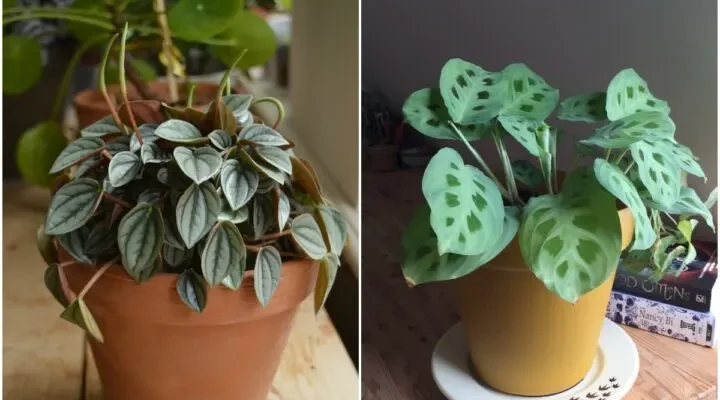Perhaps the main reason why I love houseplants is because they can make any house feel like a home. Bring a houseplant into a room and it will instantly create a cheerful, cozy and welcoming atmosphere.
As usual, I speak from experience here. Over the course of about six years, my husband and I hopped from one gloomy apartment to another.
There was the first-floor apartment overlooking a hill on one side and garages on the other. Followed by an attic converted into an “apartment” where the only sources of light were north-facing windows and a skylight right above the shower.
Then there was the apartment where the living room windows overlooked a cathedral and the bedroom windows just gave into an internal courtyard (literally, a square in between houses).

In one particularly gloomy set-up, I thought to myself that the only form of life I could grow in that apartment would be mold.
All these places were in cities with a tight housing market, so we rented what we could find. Decor came second. And we certainly couldn’t be picky about getting enough light for our houseplant collection. Nevertheless, we managed to grow plants in all of these dark rooms. And the plants made every apartment feel like our cozy home where we could decompress at the end of the day.
Here are some of the houseplants that, in my experience, did well in north-facing windows and low-light rooms.
1. ZZ Plant or Zanzibar gem (Zamioculcas zamiifolia)
For some reason, most of the lists that include a ZZ Plant do so last. Maybe the lists are in alphabetical order. Maybe this plant is an afterthought. But for me, this is always in the top three plants I would recommend to a beginner. That’s because they’re truly low-maintenance houseplants that do really well in dark rooms.
Because it’s growing from a tuberous rhizome, the ZZ plant doesn’t need (and shouldn’t get) too much water. If it dries too much, it will start dropping leaves.

I’ve moved my Zamioculcas plant from one apartment to another, from one room to another, and from one corner to another of the same room. Not only did it not protest, but it keeps growing larger and longer fronds.
Zamioculcas does require a fair bit of dusting though. So keep in mind that you should occasionally wipe the dust off the glossy dark green leaves. I do this about once a month, but if your ZZ plant is in a high-traffic spot, you might need to dust it every couple of weeks.
2. Snake plant (Sansevieria)
I’ve always been a big fan of Sansevierias, and I’m so glad they’ve had a resurgence in popularity over the past five years or so. I’m old enough to remember a time when they were considered old-fashioned or “granny’s houseplant” – together with aspidistras and spider plants.
As for me, I can’t get enough of “grandma plants.” Back in the day, those grannies didn’t have the luxury of worrying about humidifiers, grow lights or fancy fertilizers. So no mollycoddling plants, please and thank you! Only the tough ones survived.

Perhaps the idea of snake plants as old-fashioned is because you’re thinking of the popular Sansevieria laurentii (also known as mother-in-law’s tongue). It’s an excellent starter plant for rooms with low light. But if you’re looking for something a bit different, I can recommend Sansevieria bacularis and Sansevieria Kirkii. They’re leaner and could be more suitable for small spaces.
In one of our previous rentals, my Sansevieria bacularis (in the photo above) was growing next to a north-facing window that gave onto a courtyard. It was getting zero direct sunlight and very limited indirect light. Yet, it was – and still is – thriving. It grew so well that I had to divide it twice.
3. Dragon tree (Dracaena marginata bicolor)
Some people call this plant “parlor palm.” Although I’ve heard this moniker applied to so many palm-like houseplants, I’d rather just keep calling it Dracaena marginata. Just to avoid confusion.
This is probably one of the very few plants that still retained some color when I grew it in low light in front of a north-facing window. While other plants tend to revert back to a washed out green, this one kept the edges of the foliage red and orange.

If this is your first time growing a Dracaena, I should warn you that it’s more of a leaf-shedder than any other common houseplant. There’s nothing wrong with it, as long as it keeps growing fresh leaves from the top. It’s just its growth pattern. Every time a leaf falls, it leaves behind a little divet in the stem. I love the pattern that it creates. I think of them as soft aging lines or wisdom wrinkles.
Unlike the other plants on this list, Dracaena marginata likes a bit more humidity, both in the air and in the soil. Don’t overwater it, but don’t let it dry up too much either.
4. Silver satin pothos (Scindapsus pictus)
I have silver satin pothos plants strewn all over my house now. And all of the plants come from a single Scindapsus that spent the first three years of its life about five feet away from a window, in low light conditions.

I love this plant for so many reasons, but most of all because of its cheerful silver pattern. When we keep houseplants in low light, we can hardly expect color. So the silver streaks contrast beautifully with the all-green foliage of other low-light houseplants that congregate in north-facing windows.
Just like with the ZZ Plant, the silver satin pothos doesn’t need too much water. The thick leaves store water pretty well, so I usually let it dry (but not bone dry) between watering sessions.



